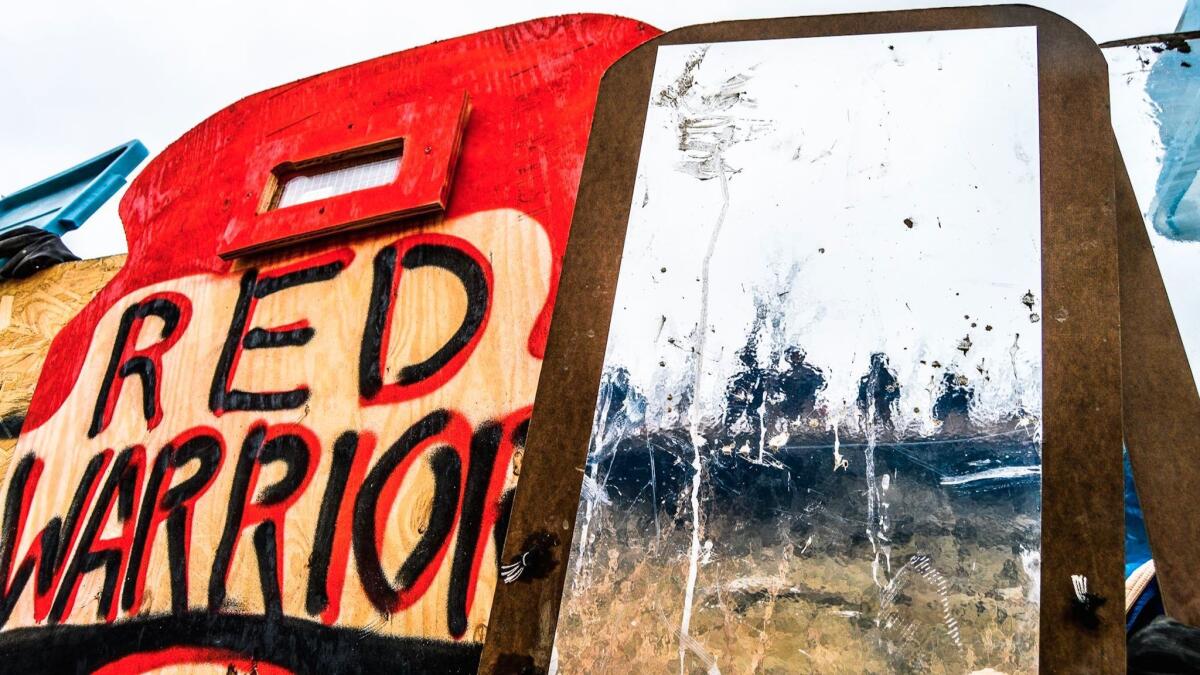Q&A: The artist who made protesters’ mirrored shields says the ‘struggle porn’ media miss point of Standing Rock
For Cannupa Hanska Luger, the protests at Standing Rock are personal. The artist, who makes sculpture, video and installations, was born on the Standing Rock reservation in North Dakota, and he is an enrolled member of the Mandan, Hidatsa and Arikara Nation, whose territory is nearby. He is in possession of German and Norwegian blood too. “I am North Dakota,” he jokes.
Now based in New Mexico, where he was recently an artist in residence at the Institute of American Indian Arts, he has been traveling to his home state over the last nine months to support the encampment in opposition to the Dakota Access pipeline. Though many protesters left the site after the U.S. Army Corps of Engineers denied a permit for the pipeline in early December — and after a hard winter set in — the encampment is still active.
In this lightly edited telephone conversation, which took place late in December, he discusses what it’s been like to watch the protests evolve, why these have been so important to Native American culture and what inspired him to produce mirrored shields to help protect activists on the front lines.
What was it like to see Standing Rock develop into one of the major news events of 2016?
It’s been pretty interesting — even more so being from that region and growing up around there. When we were kids, we used to fish and dive off of those bridges that are now the front lines. That river is home. I go back every summer guaranteed. I’ve been up seven or eight times since this whole thing began.
SPECIAL SERIES: Are Hollywood values out of touch with America? »
My dad’s side of the family, they have a ranch in the Standing Rock reservation. My mom’s side is from Fort Berthold [reservation], which is where the current oil fields are. I watched that community get destroyed by the extraction of oil. I’ve seen wells poisoned. I’ve seen the cycles of boom and bust.
Artists, we live on the periphery. But we are the mirrors.
— Cannupa Hanska Luger, artist
A lot of artists I’ve spoken with have described their journeys to the Standing Rock encampment as transformative.
It seems like everyone who has interacted with the space, there is something transformative that has happened there. The media’s general interest is in “struggle porn,” so people have missed what is beautiful about it.
When you first come through the gate — there is one entrance and one exit — they look through your car. They ask you if you have weapons or drugs. Then you are welcomed in, and they say, “Welcome home.” Your first interaction is being included, which is not something that people are used to in this country. This is an exclusive country. It’s all about fences and borders.
You set up camp and someone gives you firewood. The whole thing of guarding your stuff goes away. It’s so much easier to share things. Culturally we have a practice called “seven generations.” As you walk through the world, you are not yourself. You are not a singularity. You are not an American individualist bootstrapping bull .... You are only borrowing this place from children you will never meet. And the only reason you have an opportunity to do that is because elders took care of it for you.
Everybody came in hoping to experience something new, something profound. But when they got there, they realized they’re not a part of something new, they’ve just been absorbed into something that is much older than the entire country. That’s incredibly humbling.
What do you think Standing Rock has done for society’s understanding of indigenous culture and issues?
The big difference is that I think [people have] had the opportunity to encounter us not as a mystic, romantic other. It’s just like, “Dude, we’re just human beings.” What does “Lakota” mean in English? It literally means “the people.”
This is why we say this is not a protest, why we are water protectors. We’re not just in protest of a pipeline. What we are trying to do is maintain a cultural practice. This is our culture. It’s a part of our society.
Our original bible, that comes down from on high, it is the land. We have an oral tradition and we tell stories about magical characters that are bound to the landscape, that are bound to geology. Why is that stone red? There is a story. So where everyone else sees a pipeline and “progress,” what we see is someone going through our bible and editing things without any care, ripping a line straight through that story.
The media’s general interest is in ‘struggle porn,’ so people have missed what is beautiful about it.
— Artist Cannupa Hanska Luger on the Standing Rock protests
The battle for the pipeline isn’t over, but having the Army Corps of Engineers deny the permit certainly stands as an important victory.
The amazing thing is that whether you were Native or not, what we witnessed up there is the awakening of a giant that has been sleeping. It’s the power of us as living things — rather than us waiting for somebody to save us. It was so grass roots.
Native people have never been subject to that amount of solidarity. It left everybody awestruck. And the number of Native people coming together, nothing like this has been seen since the 19th century. Enemies that had previously been enemies, coming together — there’s no way for me to describe to you what that means. It’s far too profound.

You made a series of mirrored shields that you distributed to people on the front lines. How did that come about?
I was inspired by these activists in the Ukraine. These women — old women and children — and they came out and carried mirrors from their bathrooms and into the street to show these riot policemen what they looked like. From the photos I saw, it seemed profoundly effective. I wanted to bring that same level of recognition to the front lines there.
But Standing Rock is in the middle of nowhere. I didn’t want people to bring mirrors to the front line and get hit with batons and cause more damage than good. So what we needed was a mirrored shield. So I came up with a simple, easy and cheap design to make these mirrored shields using vinyl and Masonite — materials you can find in any hardware store. From one sheet of Masonite, you could make six shields.
I started making them after that Sunday that they were hitting people with hoses. I personally made close to 100 of them. But then another group out of Minneapolis made 500. I have no idea how many are in circulation. But I keep seeing them here and there.
What role do you think artists can have in protest?
Being an artist, it is a way to weaponize privilege. I could have been on the front line a dozen times, but my wife said, “You are one person there; you are 10,000 here — where you can engage all of these resources.”
I did a mural at the Center for Civil and Human Rights [in Atlanta] about these issues because I had the opportunity. And if I don’t utilize every amount of privilege for a cause that’s worthwhile, then what is the point? If I am not for you, then who am I for?
Artists, we live on the periphery. But we are the mirrors. We are the reflective points that break through a barrier. You don’t have to be in the same economic place that I am to relate to the work that I make. That is the power of art.
We are not rich people. But we are incredibly wealthy. We have ideas.
Below, “We Are in Crisis,” a video by artists Cannupa Hanska Luger, Dylan Mclaughlin, Ginger Dunnill, Merritt Johnson and Nicholas Galanin, that serves as a meditation on the issues at play in Standing Rock:
Sign up for our weekly Essential Arts & Culture newsletter »
»
ALSO:
Art, celebrity and how Standing Rock will shape protest in the Trump years
John Scalzi’s 10-point plan for getting creative work done in the age of Trump
The notion of a liberal agenda in Hollywood is absurd
Postcommodity’s ‘Repellent Fence’ made of air rises at the border
More to Read
The biggest entertainment stories
Get our big stories about Hollywood, film, television, music, arts, culture and more right in your inbox as soon as they publish.
You may occasionally receive promotional content from the Los Angeles Times.











